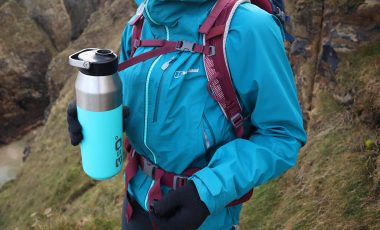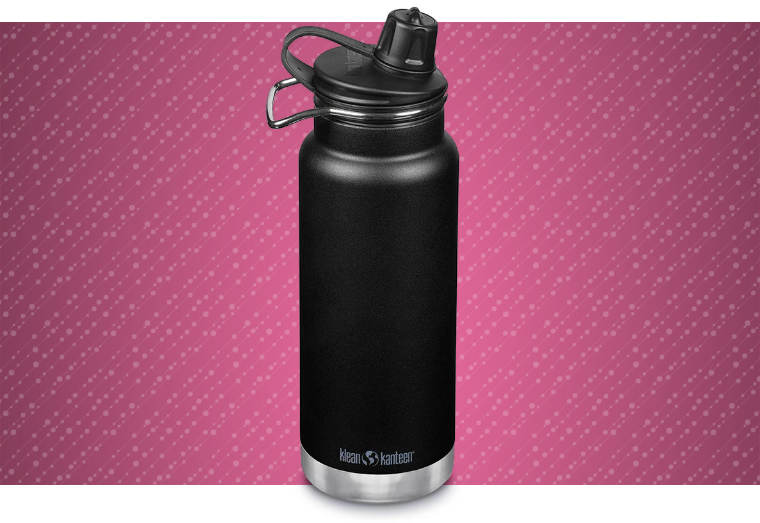Getting your water intake right is one of the most important things you can master as a hiker. Sure, route finding is also pretty key! However, if you don’t drink enough, all your well-practised map reading counts for nothing when dehydration gets the better of you. Which is why it’s SO important to ensure that you have the right water bottle for the job. I’ve been trying out all sorts of different types of water bottles over the years and my findings have culminated in this list of the best water bottles for hiking and backpacking.
From ultra lightweight backpacking water bottles to insulated water bottles that are ideal when hiking in extreme temperatures, we’ve got you covered. This list also includes a couple of the best filtered water bottles in the industry.
- The best water bottles for hiking and backpacking
- Filtration water bottles
- Desirable properties of the best water bottles for hiking
- Design features of the best water bottles for hiking
- Water bottle lids and mouth types
Summary of the best water bottles for hiking and backpacking
Disclaimer: We use affiliate links and may receive a small commission on purchases.

| Product | Weight | Capacity | Mouth | Features | Cost |
|---|---|---|---|---|---|
| Sea to Summit 360º Wide Mouth Insulated Bottle | 470g / 16.6oz | 1 litre / 34oz | Wide with sip cap | Insulated | $$ |
| Klean Kanteen Insulated TKWide With Chug Cap | 531g (18.7oz) | 1 litre / 34oz | Wide with sip cap | Insulated | $$ |
| Primus TrailBottle Tritan | 179g / 6.3oz | 1 litre / 34oz | Wide with sip cap | Lightweight | $ |
| Nalgene Sustain | 177g / 6.25oz | 1 litre / 34oz | Wide | Lightweight | $ |
| Platypus DuoLock Soft Bottle | 144g / 1.6oz | 1 litre / 34oz | Narrow | Soft flask | $ |
| Earthwell Woodie Water Bottle | 255g (9oz) | 800ml / 27oz | Standard | Lightweight | $$ |
| GSI Outdoors Microlite 1000 Twist Vacuum Water Bottle | 369g / 13oz | 1 litre / 34oz | Wide with sip cap | Insulated | $$ |
| Hydro Flask Lightweight Wide Mouth Trail Series | 312g / 11oz | 710ml / 24oz | Wide | Lightweight, insulated | $$$ |
| Sigg Bottle Mountain | 147g / 5.2oz | 1 litre / 34oz | Narrow | Lightweight | $ |
| Water-to-Go Sugarcane Water Filtration Bottle | 115g / 4.04oz | 550ml / 18.5oz | Wide with sip cap | Built-in filter | $$ |
| Grayl Ultralight Compact Purifier Bottle | 308g / 10.9oz | 473ml / 16oz | Wide | Built-in filter | $$$$ |
| Lifestraw Go Water Filter Bottle | 244g / 8.6oz | 1 litre / 34oz | Wide with straw | Built-in filter | $$$ |
The best water bottles for hiking and backpacking


Sea to Summit 360º Wide Mouth Insulated Bottle
Best for: Day hikes in the summer, group hot drinks on winter day hikes
The Sea to Summit 360º Wide Mouth Insulated Bottle is a large and heavy water bottle. It’s not the kind of bottle you’d be considering taking on multi-day treks, however it is one of the best insulated water bottles and a superb option, like the Klean Kanteen below, for hot day hikes when sipping cold water is non-negotiable. Speaking of sipping, the narrow sip lid is a joy to drink from without compromising on the highly useful wide mouth opening. I also really love the magnetic sip cap, which I thought was a bit gimmicky to start with! It sticks to the large bail handle when it’s not screwed on and is an excellent solution to the problem of lost caps.
This highly durable, double walled stainless steel insulated bottle is also super useful on day hikes in the winter. A litre of hot tea / soup / coffee is guaranteed to raise the spirits of the whole group. Plus, it pours as well as it sips. So no spillages on frosty fingers.
Pros
- Keeps cold drinks cold for up to 24 hrs
- Keeps hot drinks hot for up to 12 hrs
- Very durable
- Versatile
- Wide mouth with sip lid is the best of both worlds
- Feels great to drink from
Cons
- Heavy
- Not dishwasher safe
Find the latest price at:
Sea to Summit
Klean Kanteen Insulated TKWide With Chug Cap
Best for: Day hikes in the summer, group hot drinks on winter day hikes
Weighing 531g (18.7oz) the Klean Kanteen Insulated TKWide is the heaviest of all the bottles we’ve tested. Like the above Sea to Summit 360º bottle, it’s not very well suited to backpacking where low weight really matters. But if it’s lots of cold water you’re after during day hikes in hot conditions or on long road trips where cold water is an absolute must then this is the bottle for you; it keeps liquid chilled for up to 66 hours!
The leak-proof chug cap is a highly appealing feature for on-the-go sipping thanks to the soft silicone mouthpiece that doesn’t bash against your teeth as you walk and drink! Another useful feature is the clip that attaches the opened cap onto the handle so that it stays out of the way as you drink. And the fact that it’s dishwasher safe is also a big thumbs up, especially if you want to fill it with electrolytes or sweet drinks.
During winter, it’s a good option for picnics and short walks when filled with hot choccie or coffee. Just keep your walk on the short side as it starts to lose heat after about 5 hours.
Pros
- Good carry handle
- Very comfortable mouthpiece
- Excellent at keeping drinks cold
- Dishwasher safe and easy to clean
- Has lid cap clip
Cons
- Heavy
- Heat retention could be better
Find the latest price at:
Klean Kanteen
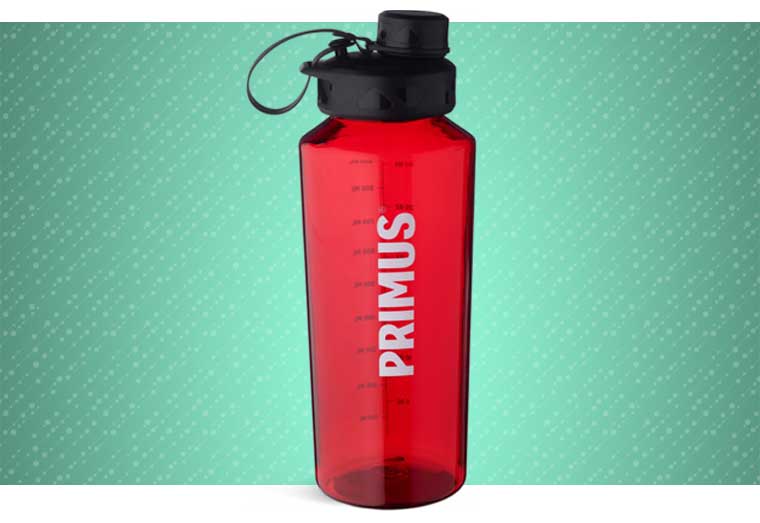

Primus TrailBottle Tritan
Best for: lightweight backpacking and overnight hiking trips
It’s lightweight, durable, versatile and BPA-free. And for me, the Primus TrailBottle Tritan is the best water bottle for backpacking on the list. Though highly comparable to the Nalgene Sustain in many aspects, the Tritan comes out on top in a few areas. Firstly, it has a wide mouth, like the Nalgene, but it also boasts a sip lid with attached cap for elevated levels of versatility both on the trail and at camp. This makes sipping on the go and pouring at camp much easier without sacrificing all the benefits of the wide opening. The bottle also has a tapered shape which is narrower at the base and much more useful than you might think. It makes it easier to hold and also easier to shove into tight backpack pockets.
The final thing that makes this lightweight bottle so good for backpacking is the volume measurements, which the Nalgene also has.
It won’t win any prizes for how nice it is to drink from and it’s no good at insulating, but when it comes to practicality, it does the job and it does it well.
Pros
- Lightweight
- Highly versatile lid and opening
- Volume measurements
- Tapered shape makes it easy to pack and hold
- Attached cap
- Dishwasher safe
- BPA-free
Cons
- Not especially pleasing to drink from
Find the latest price at:
Primus | Alpine Trek | Amazon


Nalgene Sustain
Best for: lightweight backpacking and overnight hiking trips
New to the Nalgene range in 2020 is the eco-friendly Nalgene Sustain. Boasting the same solid and much-loved design as the classic Nalgene bottles, the Sustain is another excellent option for lightweight backpacking and hiking. Though not quite as versatile as the Primus, it’s still a go-to choice when low weight and functionality are key. Like the Primus, it features volume measurements and an attached screw lid that is leak-proof.
The Sustain is also constructed with super durable and revolutionary Tritan™ Renew resin that is incredibly solid. In all my years of seeing Nalgene bottles flung on the ground and bashed about, I’ve never encountered a cracked or damaged one. And with a lifetime guarantee, it really is a superb choice for eco-conscious hikers who desire a lightweight bottle.
Pros
- Lightweight
- Eco-friendly
- Volume measurements
- Attached lid
- Dishwasher safe
- BPA/BPS and phthalate-free
- Lifetime guarantee
- Taste and odour-resistant,
Cons
- Not especially pleasing to drink from
Find the latest price at:
REI | Nalgene


Platypus DuoLock Soft Bottle
Best for: ultralight backpacking and fastpacking
If you’re looking for an ultralight backpacking water bottle then look no further than the Platypus DuoLock Soft Bottle. Weighing only 144g / 1.6oz, it’s the lightest bottle on the list, closely followed by the Sigg. Its low weight and packability make it ideal for lightweight backpacking and fastpacking when every gram and inch of space counts. You can shove it into smaller pockets on your backpack that regular water bottles won’t fit into or even clip it onto the outside of your pack using the carabiner clip if you’re really struggling for space. Plus, once it’s empty it rolls up into a tiny little package that disappears in your pack.
Another useful feature is its ability to stand up. Though it’s certainly not stable when stood, it’s a feature that makes it more useable when cooking at camp. Additionally, the dual-locking flip cap opens for easy sipping and pouring, and the whole lid unscrews for easier filling and cleaning.
Yes, it’s an excellent and lightweight water bottle, but it’s not without a couple of downsides. Firstly, volume measurements would be a very natural and easy addition to the print that would make the bottle more useful on multi-day trips. Secondly, it takes ages for the insides of the bottle to dry.
Pros
- Ultra lightweight
- Flat packed when empty
- Carabiner clip
- Dishwasher safe
- BPA/BPS and phthalate-free
Cons
- Takes ages to dry out inside
- Doesn’t have volume measurements
- Not very durable
- Not especially easy or enjoyable to drink from
Find the latest price at:
Platypus | REI


Earthwell Woodie Water Bottle
Best for: short day hikes and everyday use
The Earthwell Woodie Water Bottle gains some serious Brownie points in terms of aesthetics and how pleasing it is to use. The hardwood cap is a delight to use and look at, as is the EarthGrip powder coat finish which is easy to grip and feels very nice in the hand.
Thankfully, there’s more to this 800ml / 27oz water bottle than just style and feel. It’s an excellent choice for short day hikes when you don’t need or want to carry much weight but want a cool drink to refresh you on the trail. Though not insulated, the kitchen-grade electropolished stainless steel bottle keeps water cool for much longer than plastic bottles, without adding too much extra weight. It’s smaller volume is also appealing for just chucking in your daypack or handbag when you’re out and about.
The D-ring handle makes carrying easy and the standard mouth width allows for a little more versatility and ease of cleaning than narrow mouthed bottles. As such, the Earthwell Woodie has fast become my go-to bottle for short walks and everyday use.
Pros
- Lightweight for a metal bottle
- Gorgeous design
- Pleasing to use and drink from
- Dishwasher safe but lid hand washed
- BPA-free and phthalate-free
- Electropolished stainless steel doesn’t transfer taste
- Recyclable
Cons
- Doesn’t insulate well
Find the latest price at:
Earthwell
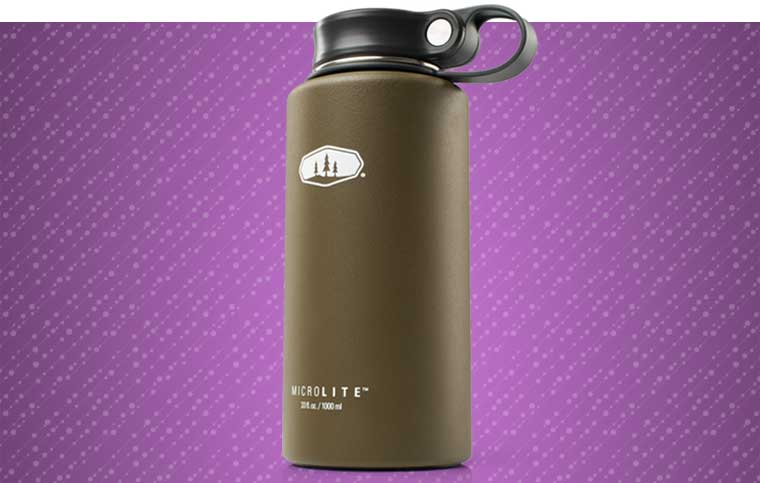

GSI Outdoors Microlite 1000 Twist Vacuum Water Bottle
Best for: day hikes and overnight trips in hot and cold weather
If you love the shape and functionality of Nalgene bottles but want the benefits of insulation, the GSI Outdoors Microlite 1000 Twist Vacuum Water Bottle should definitely be considered. Yes, it’s over twice as heavy, so not a great choice if low weight is top priority. But 369g / 13oz for a 1 litre vacuum-insulated bottle is impressively lightweight; a third lighter than its competitors, so GSI Outdoors claims!
Weight aside, the Microlight really is also impressively streamlined thanks to its thin walls (2mm). This means that it’s surprisingly packable in backpack side pockets and also not too chunky to hold when drinking out of it. It has a very pleasing lip to sip from and the attached screw lid manages to not get in the way when drinking (like the Nalgene lid does).
Like the Sea to Summit 360º bottle, I love that the Microlite is as useful in the winter as it is in the summer. And recently I’ve been enjoying using it for camping cocktail making! As an aside, pre-made hot toddy’s and Baileys hot chocolates are the biggest crowd pleasers. But the bottle also makes a rather excellent shaker when mixing cocktails. The wide mouth allows for stirring, as well as shaking, and provides plenty of room for adding ice.
My favourite feature of this exceptionally well-made insulated bottle is the rubber bottom. It’s the only bottle on the list with one and I really do notice and enjoy it as a positive feature. It adds a degree of stability when camp cooking and lowers the toppling rate when placed on uneven surfaces. It’s also just really nice to not clang the bottle down on a table – a little like a soft close cupboard!
Pros
- Lightweight for an insulated bottle
- Has a rubber bottom
- Keeps hot drinks hot for 15hrs
- Keeps cold drinks cold for 27hrs
- Highly durable
- Attached screw lid doesn’t get in the way
- Very pleasing to drink from
Cons
- Not dishwasher safe
Find the latest price at:
Amazon


Hydro Flask Lightweight Wide Mouth Trail Series
Best for: day hikes in hot and cold weather and everyday use
Finally, Hydro Flask have realised the need for a lighter weight version of their ever-popular insulated bottles. New to the market in 2021, the Hydro Flask Trail Series is a highly appealing option for those hitting the trail with as little weight in their packs as possible without having to sacrifice insulation. This sleek bottle is, in fact, 25% lighter than regular Hydro Flask bottles. The stainless steel walls are thinner and the flex cap has a perforated handle and aluminium pivots to further reduce weight.
Performance-wise, this is one of the nicest bottles to drink from on this list. The wide mouth and fine lip are very similar to the GSI Outdoors Microlite in terms of size and feel. And the slim design of the bottle is as easy to hold as it is to slip into the side pocket of a day pack
The bale handle makes for easy and comfortable carrying, and the screw lid only takes a couple of twists to loosen.
Overall, this is a superb option for day hikes when you want to keep your drinks at their correct temperature. But it also fits very well into everyday life, thanks to its stylish design and low weight; a perfect handbag bottle!
Pros
- Lightweight for an insulated bottle
- BPA-Free and Phthalate-Free
- Really nice to hold and drink from
- 24 hours cold
- 12 hours hot
- Lifetime warranty
Cons
- Pricey
Find the latest price at:
Hydro Flask | REI | Wildbounds


Sigg Water Bottle Traveller
Best for: lightweight backpacking and overnight hiking trips
After the Platypus Soft Flask, this 1 litre aluminium bottle is the next lightest option on our list. Weighing a miniscule 147g / 5.2oz, it’s the best lightweight water bottle for hiking, especially if durability is a priority. I’ve had my Sigg bottle for decades (as you may be able to tell!). It’s still going strong and has also not inherited any tastes of yesteryear! Plus, at the end of its life the aluminium is easy to recycle, the same as the Earthwell.
Functionally, the Sigg is pretty simple. The narrow mouth is easy and pleasant enough to drink from, though nothing out of the ordinary. The handle is easy to hold with one finger and big enough to clip on a carabiner. The screw cap still works well after many years of use, keeping the liquid tightly locked inside. However, I’ve always disliked this cap. It takes a lot of twisting to undo and it’s easy to misalign the thread when screwing it back on. This results in me drinking less on the trail.
The final thing to mention is that its contents can get horribly hot when left out in the sun for too long! I have a neoprene sleeve to help prevent this.
Pros
- Super durable
- Exceptionally lightweight
- Simple design
- BPA-free
- Taste-free
- Recyclable
Cons
- Screw lid is a little clunky to use
- Doesn’t insulate drinks in extreme temperatures
Find the latest price at:
Sigg | Amazon | Alpine Trek
Filtration water bottles
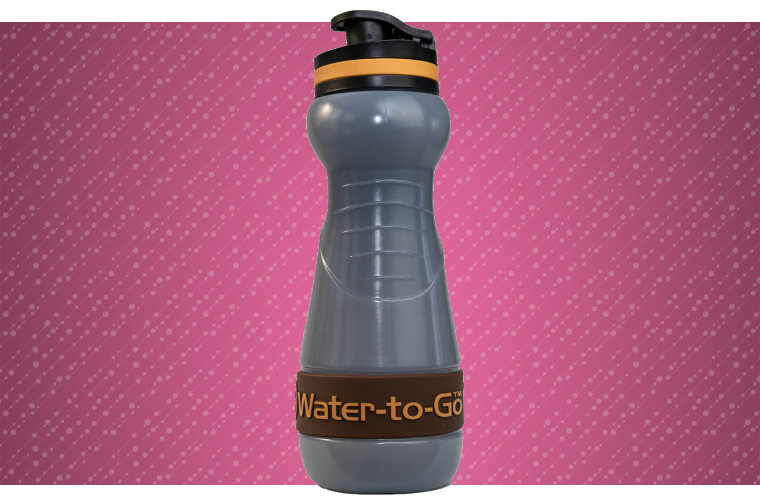
Water-to-Go Sugarcane Water Filtration Bottle
Best for: remote backpacking and hiking
New to the Water-to-Go range in 2023, the Sugarcane Water Filtration Bottle the lightest option on our list (115g / 4.05oz) and is ideal for those looking for a more responsibly made water bottle. The entire bottle is made from the fibrous residue that is leftover from the processing of sugar, which is fermented into ethanol and then further processed to form a plant-based plastic. Clever stuff!
In terms of filtration, it competes fiercely with the below Grayl Filter, offering the same level of protection from nasties in the water, to include viruses, bacteria, protozoa, cysts, fluoride and chlorine, as well as chemicals and heavy metals. However, it’s easier to use than the Grayl (no pushing down of the filter required) and it has a larger capacity of 550ml / 18.5oz. As such, I use it above any other filter when hiking in the UK and along the Cornish coast where many of the waterways are contaminated with metals and chemicals.
From a drinking point of view, I really like the narrow sip lid – similar to the Primus and Sea to Summit bottles – which makes for easy on-the-go drinking. And the flip lid means there’s no chance of losing the lid on the trail. Additionally, the filter is easy to remove if you just want to use the bottle for everyday use. And the ergonomic shape makes it really easy to carry if you don’t want or need to walk with a backpack.
The main downside is the lack of hook or attachment point. And its capacity is also on the low side.
Pros
- Filters chemicals, heavy metals and pesticides
- Removes viruses (as well as bacteria and protozoan cysts)
- Streamlined and ergonomic design
- Filter is replaceable
- BPA-free
- Not made from plastic
- Can be easily used without the filter
- Dishwasher safe
Cons
- Small volume (550ml / 18.5oz)
- Not as tough as other options
- No attachment loop or hook
Find the latest price at:
Water-to-Go
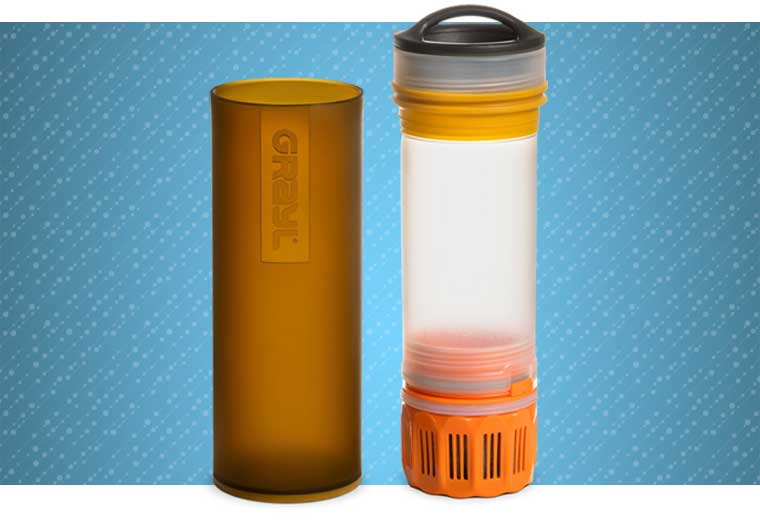

Grayl Ultralight Compact Water Purifier
Best for: remote backpacking and hiking
With the capacity to hold only 473ml / 16oz of water, the Grayl Ultralight Compact Water Purifier offers the least amount of hydration potential of all the bottles on our list. However, for those finding themselves hiking, biking and adventuring in remote places, the Grayl actually offers unlimited hydration potential! Its built-in filter not only works its magic in a matter of seconds, but it’s also one of the most effective filter bottles on the market. Boasting the ability to filter waterborne pathogens (VIRUS, bacteria, protozoan cysts) as well as pesticides, chemicals, heavy metals and microplastics, this all-in-one filter bottle is a no-brainer for remote adventures.
Its ability to remove waterborne viruses and filter out heavy metals, pesticides and chemicals also make it ideal for use in less remote areas such as farmland or coastal areas that have been mined. It’s constructed from durable food-grade plastic and silicone and deals very well with being bashed about.
To use, simply remove the internal cylinder, fill the bottle with whatever water you have access to and press the internal cylinder back into the bottle. Done!
Like the Nalgene, it doesn’t win any prizes for sophisticated sipping! But its wide mouth and twist lid perform as they should with a small D-loop handle adding a degree of useability for storage and carrying.
Pros
- Built-in filter
- Filters in 15 seconds
- Removes viruses (as well as bacteria and protozoan cysts)
- Filters chemicals, heavy metals and pesticides
- BPA-free
- Replaceable filter cartridge
Cons
- Small volume (473ml / 16oz)
Find the latest price at:
Grayl | REI
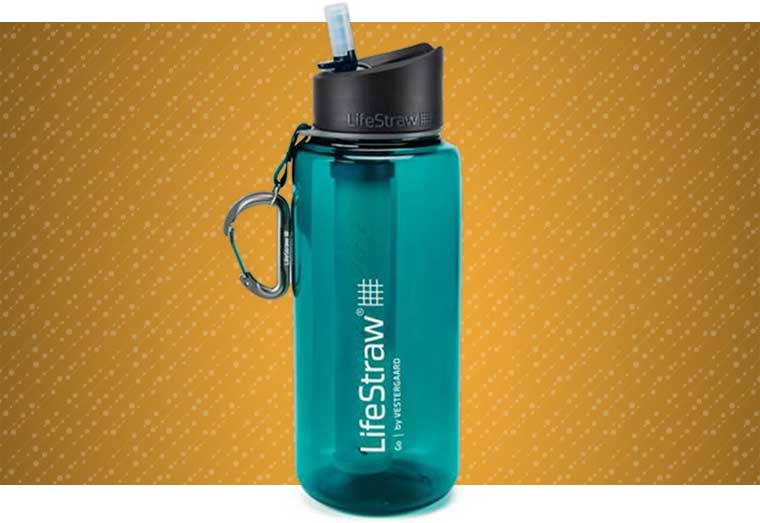

LifeStraw Go Water Filter Bottle
Best for: remote backpacking and hiking
LifeStraw has been doing great things over the past 20 years, and not just in terms of product development. In 2014 the brand launched their Give Back program which ensures that a child in need receives safe water for a year for every LifeStraw purchased at retail. Just one of the many reasons why this Water Filter Bottle gets two thumbs up. Other reasons include its tough construction (similar to the Nalgene and Primus bottles), its large capacity and how easy it is to use. Simply fill the bottle up with dirty water, place the filter into the bottle, screw up the lid and sip away!
In terms of filtering effectiveness, it doesn’t quite compete with the Grayl (doesn’t remove pesticides, heavy metals, viruses and chemicals). However, it does remove 99.999999% of bacteria, 99.999% of parasites, 99.999% of microplastics whilst reducing chlorine, organic chemical matter and turbidity for an improved taste. It’s also a little less expensive with over twice the capacity making it much better suited to trails and traveling where filling up often isn’t guaranteed.
This is the only straw mouthpiece on our list which is super easy to sip from. Once it gets flowing there’s not a struggle to get water through! Plus, the carabiner attachment makes it much easier to secure to a backpack than the Grayl.
Pros
- Super easy to use as a water filter
- Straw mouthpiece is easy to sip from
- Good volume size for a filter bottle (1 litre)
- BPA-free
- Removes bacteria, parasites and microplastics
- Has carabiner attachment
- Wide mouth is easy to fill and clean
Cons
- No volume measurements
- Doesn’t filter viruses, pesticides and heavy metals
Find the latest price at:
Lifestraw | REI | Wildbounds
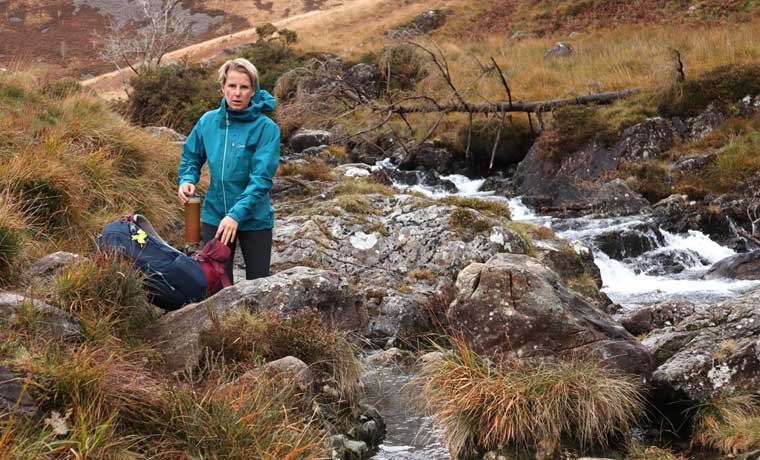
Desirable properties of the best water bottles for hiking
Though it may be easy to assume that a water bottle is a water bottle and any old thing will do for hiking, there’s actually a lot of things to consider. Some of the below may be more important than others, depending on your needs, wants, the climate and whether you’re day hiking or multi-day backpacking.
Weight
For long distance hikers and backpackers, a lightweight water bottle is a must. Every little bit of weight that can be saved will make life more enjoyable on the trail. Low weight is also an important factor for fastpacking. Day hikers or those not doing big distances can afford to sacrifice low weight for other more desirable / applicable properties like insulation or durability. The bottles on our list range from 144g to 470g (1.6oz to 16.6oz).
Durability
The durability of water bottles largely comes down to the materials that they’re made of. The flexible plastic of a soft flask won’t last anywhere near as long as a double wall stainless steel bottle. So if you’re after something to last a lifetime then opt for a heavier stainless steel water bottle. However, if low weight is as important as durability then aluminium and plastic bottles are a good compromise, offering lower weight but good levels of durability.
Chemical-free
Gone are the days, thankfully, when chemical-filled plastic bottles were the norm. However, they do still exist. So if you want a plastic water bottle or the lid to your water bottle is made of plastic, then be sure to look for options that are BPA-, BPS- and Phthalate-free.
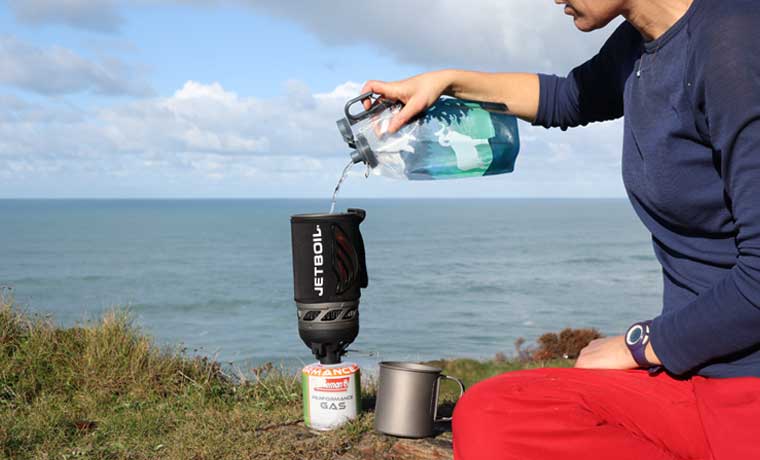
Ease of use
This may seem like an odd one, but when you’re sipping from your bottle multiple times a day, it’s important that it’s easy to do! A couple of things to consider in this regard are:
The type of lid – does it screw on and off easily? Are there lid components that are easy to mislay? If it’s a sip cap, is it easy to use and drink from?
The feel of the bottle – does it slip through your hands easily or not? Is it narrow enough to easily hold?
Taste
This is an often overlooked feature, but more important than you may think, and is a two-fold thing. Firstly, drinks stored in some plastic bottles tend not to taste as pure as drinks stored in metal. Secondly, certain drinks can leave their taste on the inside of certain bottles more easily than others. If you intend using your water bottle for coffee, tea and sports drinks, as well as water, then look for a bottle that doesn’t hold taste easily and is odourless.
Capacity
The size bottle you choose comes down to personal preference and is generally specific to certain scenarios. A 750ml water bottle will be quite sufficient for a short day hike in the winter. However, anything else and you’ll need more; up to 3 litres a day depending on climate and distance. So ideally you’ll need a couple of 1 litre bottles or a hydration bladder plus a 1 litre bottle.
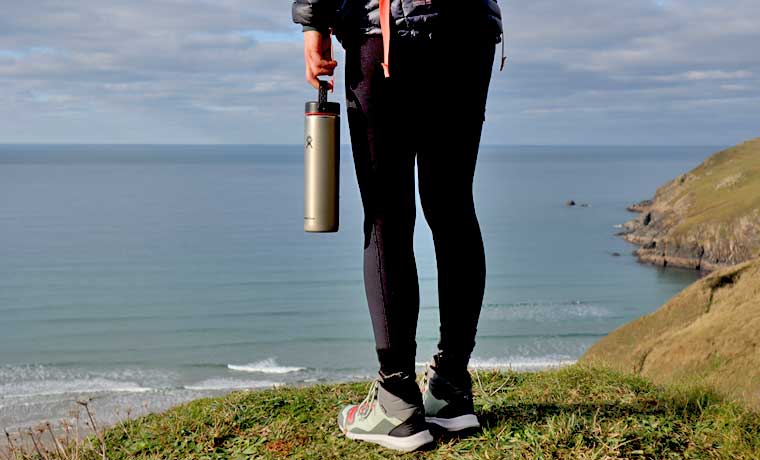
Insulation
Insulated bottles are the heaviest type of water bottle as they usually have double walls and are made of stainless steel. If you intend to use your water bottle for hot drinks in the winter then opting for an insulated bottle is a great idea, if you don’t mind the weight. Additionally, if you predominantly hike in very hot climates then an insulated bottle will prevent you from sipping luke warm water all day.
Dishwasher safe
Most insulated water bottles and flasks tend not to be suitable for dishwasher cleaning. However, plastic and aluminium bottles are. If this is an important feature to you then be sure to check before you buy.
Enjoyment
Finally, and probably least importantly in the grand scheme of things, your water bottle should ideally be enjoyable to drink from. And in all honesty, the more you drink from it enjoyment can become more important than you might initially realise. A couple of things that add to my water bottle drinking enjoyment levels are:
The feel of the bottle on my lips. Is the lip too thick or too sharp around the edges? Is it made from plastic or metal?
The feel of the bottle in my hands. Does it slip through my hands easily or is it nice and grippy? Is it too wide to easily hold with one hand?
Neither of the above are deal breakers, but something to consider all the same.
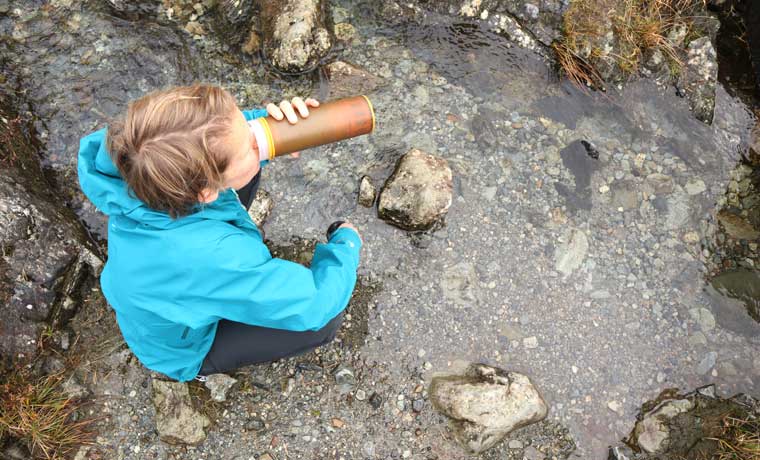
Design features of the best water bottles for hiking
So you know what material you want your water bottle to be made of, you know the size and weight you need. But what about all the other features? Yes, there really is more to consider when choosing the best water bottles for hiking and backpacking!
Handle
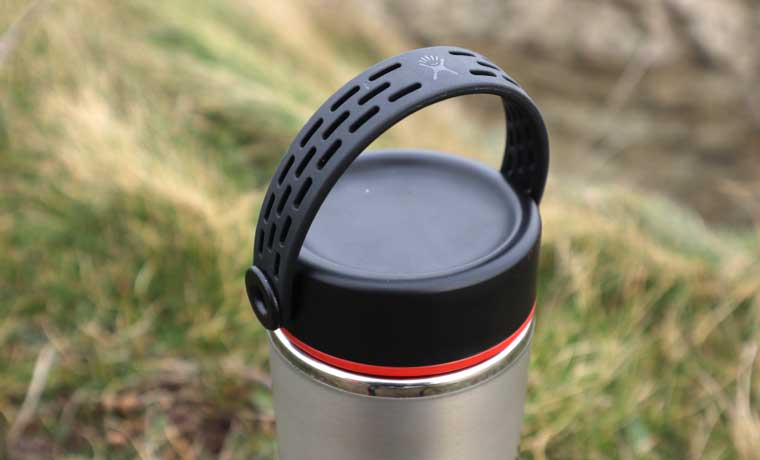 Useful for hauling it out of your back, for carrying it as you walk or for attaching it / hanging it to stuff. Bail handles allow you to fit your whole hand around the handle, whereas loop handles are designed to be held with a couple of fingers.
Useful for hauling it out of your back, for carrying it as you walk or for attaching it / hanging it to stuff. Bail handles allow you to fit your whole hand around the handle, whereas loop handles are designed to be held with a couple of fingers.
Volume measurements
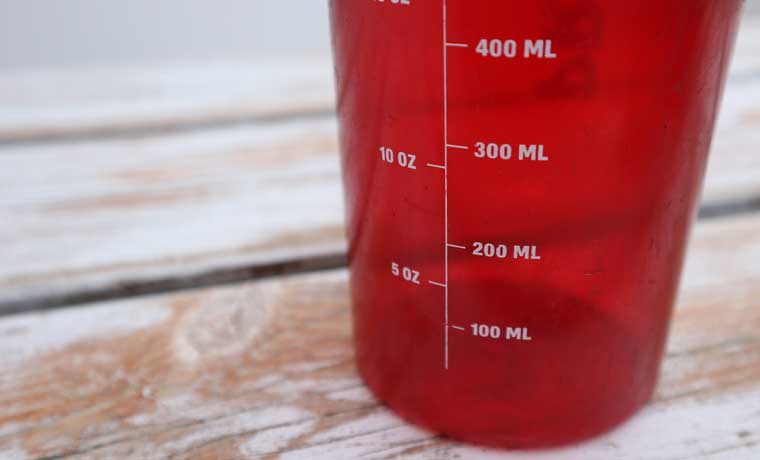 If you are using your water bottle for cooking at camp or you’re mixing energy drinks etc in your bottle then having measurements is a really useful feature. It’s also good if you need to monitor or ration your liquid intake when hiking. The Nalgene, Platypus and Primus bottles all feature volume measurements.
If you are using your water bottle for cooking at camp or you’re mixing energy drinks etc in your bottle then having measurements is a really useful feature. It’s also good if you need to monitor or ration your liquid intake when hiking. The Nalgene, Platypus and Primus bottles all feature volume measurements.
Rubber base
 Though most water bottles for hiking don’t have the luxury of a rubber bottom, this is a really nice feature that adds a significant degree of stability to tall bottles on uneven surfaces. The GSI Outdoors Microlite is the only bottle on the list with a rubber base.
Though most water bottles for hiking don’t have the luxury of a rubber bottom, this is a really nice feature that adds a significant degree of stability to tall bottles on uneven surfaces. The GSI Outdoors Microlite is the only bottle on the list with a rubber base.
Attached lid
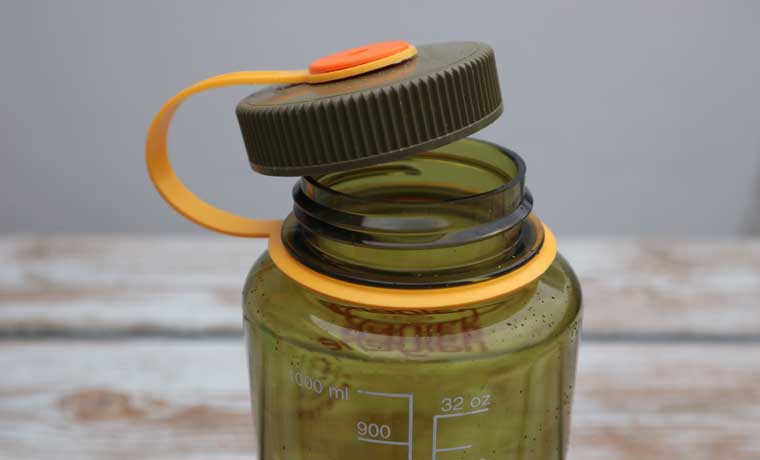 Another useful feature is having a lid that stays attached to the bottle once it has been unscrewed. This avoids the possibility of losing the lid. Examples of this are the Primus, Nalgene and GSI Outdoors bottles.
Another useful feature is having a lid that stays attached to the bottle once it has been unscrewed. This avoids the possibility of losing the lid. Examples of this are the Primus, Nalgene and GSI Outdoors bottles.
Built-in filter
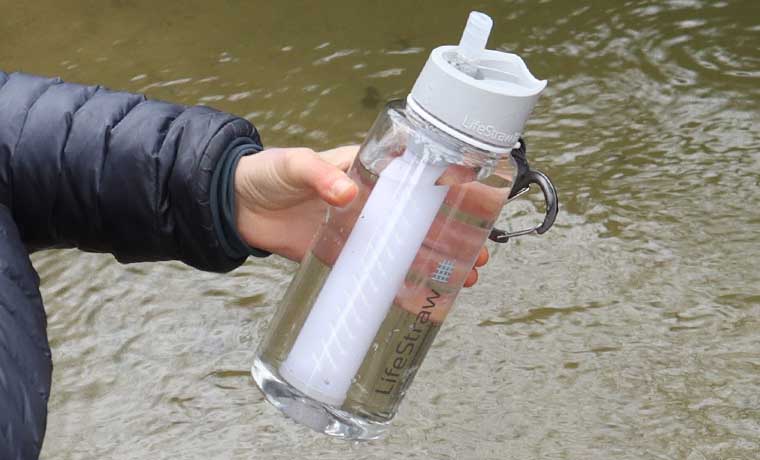 For those hiking and backpacking in the backcountry or in foreign countries where water sources are not to be trusted, a filter bottle is a great option. They’re a super convenient way to get unclean water bottled up instantly without having to filter and decant water using a separate filter. The main downside of this is that once the bottle has been filled with unclean water, it shouldn’t be used without the filter until it’s been properly cleaned.
For those hiking and backpacking in the backcountry or in foreign countries where water sources are not to be trusted, a filter bottle is a great option. They’re a super convenient way to get unclean water bottled up instantly without having to filter and decant water using a separate filter. The main downside of this is that once the bottle has been filled with unclean water, it shouldn’t be used without the filter until it’s been properly cleaned.
Water bottle lids and mouth types
The final thing to consider when choosing a water bottle for hiking and backpacking is the type of lid and mouth the bottle has. Here are the options:
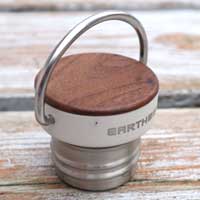
Screw top
Most water bottle lids are screw tops. These tend to be much more leak-proof than alternative types of lids.
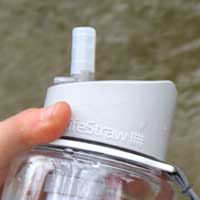
Straw top
Some bottle lids have screw tops which have an integrated straw to drink from, like the Lifestraw Go. These are great for easy sipping on the go, but also have more parts to them that can fail or leak.
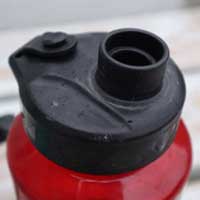
Sip lid
Like lids with straws, some bottle lids have a sipping hole integrated into them. The Sea to Summit and Primus bottles are examples of this. These examples are simple and less complex mechanisms than straw lids or other types of sip lids that may have twisting or snap shut closures. Simple sip lids are less likely to leak or fail.
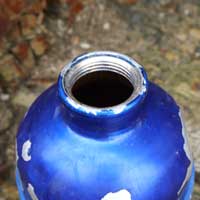
Narrow mouth
Bottles with narrow openings, like the Sigg, measure around 3.5cm across the mouth. These are the easiest size to drink from when you’re on the go. But they’re not as easy to clean as standard and wide mouth bottles.
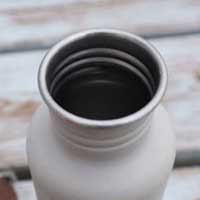
Standard mouth
Standard bottle mouths usually measure around 4.5cm across, like the Hydro Flask and Earthwell bottles. They’re easier to clean than narrow mouth bottles and you can easily add ice cubes etc to your water.
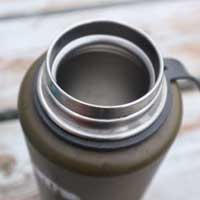
Wide mouth
These measure around 5.5cm across their opening and are the easiest to clean of all the mouth size options. They’re also a little more versatile when cooking and eating at camp; you can stir a soup in one, for example!


